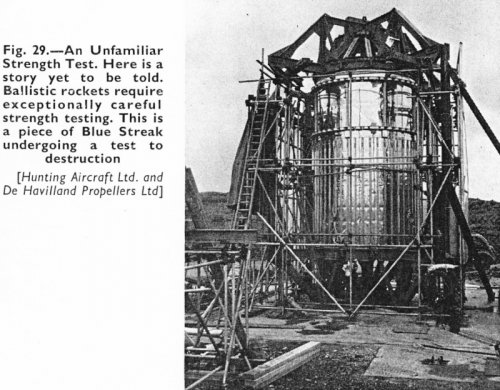Your name isn't Pandora, perchance? Blue Streak, ah, benefited greatly from US data, pace: Proceedings, 17/3/99 R.Ae.S Symposium, History of the UK Strategic Deterrent: “some US ideas rather than hard data”. This is quite as tetchity an issue as TSR.2. Here are dates/facts (US items: J.N.Gibson,History of the US Nuclear Arsenal,Bison,1989):
1/3/54: US tests a lightweight warhead within its MX research program;
26/7/54: Churchill funds an IRBM and its lightweight Orange Herald warhead;
12/6/54 - 30/7/54: Sandys (then at MoS) negotiates a UK/US MoU for GW data "exchange", inc. licencing Rocketdyne propulsion and Sperry guidance;
MoS struggles as between in-house work (like munitions in ROFs) and placement into industry. Which industry? EE(GW) declines to be involved. (sometime in) 1955: MoS ITP on DH Props.;
14/1/55: DoD funds Convair Atlas; Atlas D operational 31/10/59
27/10/55: DoD funds Martin Titan; Titan 1 operational 20/4/62;
8/11/55: DoD funds both USAF Douglas SM-75 Thor and Army Chrysler/Redstone Arsenal SM-78 Jupiter. Thor operational (USAF-manned) in UK from 19/9/58; Jupiter (now a USAF program) operational in Italy, US-manned, 6/61;
(in) 1956: DoD funds 15% of Blue Streak R&D estimated total of £70Mn. (and paid $8Mn to mid-58 P163,I.Clark,Nuclear Diplomacy&the Special Relationship,OUP,94); taken together with:
25/3/57: Sandys, now at Defence, makes US/UK Defense Collaboration Agreement:
much more ICBM/IRBM data was fed into Blue Streak. Which had no warhead:
3/54 Sir W.Penney “we do not know how to make any form of (thermonuclear device)” (to be Sir W.)Cook , 2/12/55: ‘does anybody (in the room) know how it’s done?’…an embarrassed silence.” L.Arnold,Britain and the H-Bomb,Palgrave,01, Pp.43,87. See Violet Club for the consequence. So, Sandys does:
22/2/58: Exchange of Notes on the Supply of IRBMs (Thor); and:
3/7/58: MoU, US W-49 licenced as Orange Herald Light for Blue Streak;
4/8/58: Agreement for Co-operation on Uses of Atomic Energy for Mutual Defense Purposes.
Nothing on Blue Streak seems to be on-schedule, on-budget; 1966 deployment seems remote; Treasury enquires, gently, what it will do that (sort-of-free) Thor will not, RAF/US dual key operational 3/6/60;
29/3/60: US offers Douglas Skybolt ALBM;
13/4/60: Blue Streak cancelled.
Now look at Lockheed's SLBM, merely one gadget within the SSBN program: DoD funded 11/4/56; first operational cruise 15/11/60.
There is no one factual A to your Q. Prime Contractor/Project Management is relevant; so is merrily cascading funding. So is: “RR share the view with everybody else (that DH) can be extremely difficult and unsatisfactory” MoS,1958, in C.N.Hill,A Vertical Empire,ICP,2001,P78.




